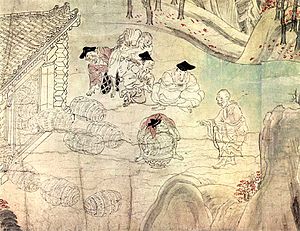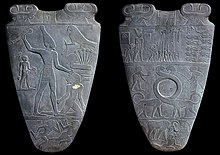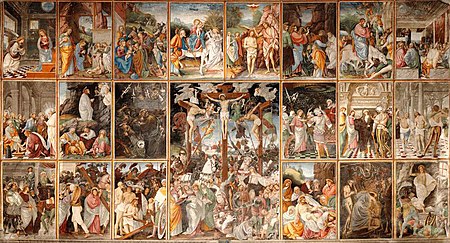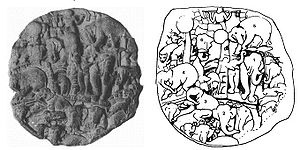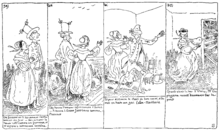
Nineveh, also known in early modern times as Kouyunjik, was an ancient Assyrian city of Upper Mesopotamia, located in the modern-day city of Mosul in northern Iraq. It is located on the eastern bank of the Tigris River and was the capital and largest city of the Neo-Assyrian Empire, as well as the largest city in the world for several decades. Today, it is a common name for the half of Mosul that lies on the eastern bank of the Tigris, and the country's Nineveh Governorate takes its name from it.
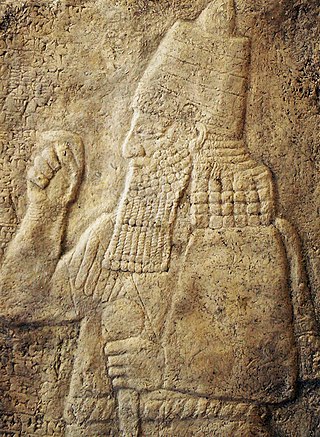
Sennacherib was the king of the Neo-Assyrian Empire from the death of his father Sargon II in 705 BC to his own death in 681 BC. The second king of the Sargonid dynasty, Sennacherib is one of the most famous Assyrian kings for the role he plays in the Hebrew Bible, which describes his campaign in the Levant. Other events of his reign include his destruction of the city of Babylon in 689 BC and his renovation and expansion of the last great Assyrian capital, Nineveh.

The Bayeux Tapestry is an embroidered cloth nearly 70 metres long and 50 centimetres tall that depicts the events leading up to the Norman Conquest of England in 1066, led by William, Duke of Normandy challenging Harold II, King of England, and culminating in the Battle of Hastings. It is thought to date to the 11th century, within a few years of the battle. Now widely accepted to have been made in England perhaps as a gift for William, it tells the story from the point of view of the conquering Normans and for centuries has been preserved in Normandy.

Ashurbanipal was the king of the Neo-Assyrian Empire from 669 BC to his death in 631. He is generally remembered as the last great king of Assyria. Ashurbanipal inherited the throne as the favored heir of his father Esarhaddon; his 38-year reign was among the longest of any Assyrian king. Though sometimes regarded as the apogee of ancient Assyria, his reign also marked the last time Assyrian armies waged war throughout the ancient Near East and the beginning of the end of Assyrian dominion over the region.

Nimrud is an ancient Assyrian city located in Iraq, 30 kilometres (20 mi) south of the city of Mosul, and 5 kilometres (3 mi) south of the village of Selamiyah, in the Nineveh Plains in Upper Mesopotamia. It was a major Assyrian city between approximately 1350 BC and 610 BC. The city is located in a strategic position 10 kilometres (6 mi) north of the point that the river Tigris meets its tributary the Great Zab. The city covered an area of 360 hectares. The ruins of the city were found within one kilometre (1,100 yd) of the modern-day Assyrian village of Noomanea in Nineveh Governorate, Iraq.

Dur-Sharrukin, present day Khorsabad, was the Assyrian capital in the time of Sargon II of Assyria. Khorsabad is a village in northern Iraq, 15 km northeast of Mosul. The great city was entirely built in the decade preceding 706 BC. After the unexpected death of Sargon in battle, the capital was shifted 20 km south to Nineveh.

Ashur-nasir-pal II was king of Assyria from 883 to 859 BCE. Ashurnasirpal II succeeded his father, Tukulti-Ninurta II. His son and successor was Shalmaneser III and his queen was Mullissu-mukannišat-Ninua.
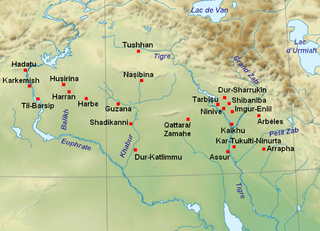
Balawat is an archaeological site of the ancient Assyrian city of Imgur-Enlil, and modern village in Nineveh Province (Iraq). It lies 25 kilometres (16 mi) southeast from the city of Mosul and 4 kilometres (2.5 mi) to the south of the modern Assyrian town of Bakhdida.
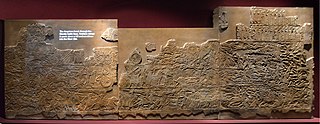
The Battle of the Ulai River, also known as the Battle of Til-Tuba or the Battle of Tulliz, in c. 653 BCE, was a battle between the invading Assyrians, under their king Ashurbanipal, and the kingdom of Elam, which was a Babylonian ally. The result was a decisive Assyrian victory. Teumman, the king of Elam, and his son Tammaritu were killed in the battle.

The Department of the Middle East, numbering some 330,000 works, forms a significant part of the collections of the British Museum, and the world's largest collection of Mesopotamian antiquities outside Iraq. The collections represent the civilisations of the ancient Near East and its adjacent areas.

The art of Mesopotamia has survived in the record from early hunter-gatherer societies on to the Bronze Age cultures of the Sumerian, Akkadian, Babylonian and Assyrian empires. These empires were later replaced in the Iron Age by the Neo-Assyrian and Neo-Babylonian empires. Widely considered to be the cradle of civilization, Mesopotamia brought significant cultural developments, including the oldest examples of writing.

The Lachish reliefs are a set of Assyrian palace reliefs narrating the story of the Assyrian victory over the kingdom of Judah during the siege of Lachish in 701 BCE. Carved between 700 and 681 BCE, as a decoration of the South-West Palace of Sennacherib in Nineveh, the relief is today in the British Museum in London, and was included as item 21 in the BBC Radio 4 series A History of the World in 100 Objects by the museum's former director Neil MacGregor. The palace room, where the relief was discovered in 1845–1847, was fully covered with the "Lachish relief" and was 12 metres (39 ft) wide and 5.10 metres (16.7 ft) long. The Lion Hunt of Ashurbanipal sequence was found in the same palace.

Ashurbanipal, also known as the Ashurbanipal Monument or the Statue of Ashurbanipal, is a bronze sculpture by Fred Parhad, an artist of Assyrian descent. It is located in the Civic Center of San Francisco, California, in the United States. The 15-foot (4.6 m) statue depicting the Assyrian king of the same name was commissioned by the Assyrian Foundation for the Arts and presented to the City of San Francisco in 1988 as a gift from the Assyrian people. The sculpture reportedly cost $100,000 and was the first "sizable" bronze statue of Ashurbanipal. It is administered by the City and County of San Francisco and the San Francisco Arts Commission.

The Balawat Gates are three sets of decorated bronze bands that had adorned the main doors of several buildings at Balawat, dating to the reigns of Ashurnasirpal II and Shalmaneser III. Their extensive use of narrative art depicting the exploits of Assyrian kings has cemented their position as some of the most important surviving works of art of the Neo-Assyrian Empire, comparable to the extensive Assyrian palace reliefs. When the Neo-Assyrian Empire fell in 614-612 BC, Balawat was destroyed. The wooden elements of the gates decomposed, leaving only the bronze bands. The remains of two sets of gates can be found in the British Museum's collection, those from the Temple of Mamu are housed in the Mosul Museum. Small sections of the Shalmaneser bronze door bands are also in the Louvre Museum at the Walters Art Museum in Baltimore and in the Istanbul Archaeology Museums.
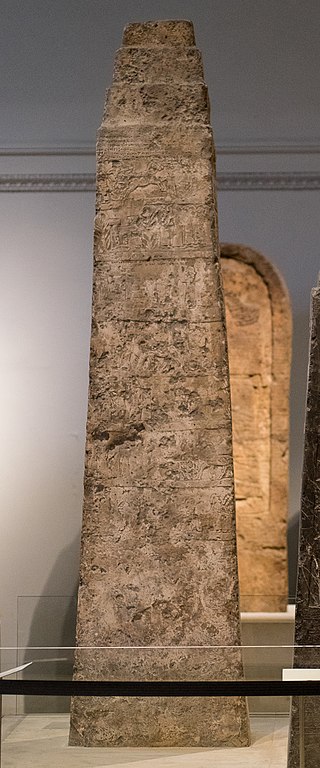
The White Obelisk is a large stone monolith found at the ancient Assyrian settlement of Nineveh, northern Iraq. Excavated by the British archaeologist Hormuzd Rassam in 1853, it is one of only two intact obelisks to survive from the Assyrian empire, the other being the Black Obelisk of Shalmaneser III. Both are now preserved in the British Museum. The White Obelisk dates to the beginning of the Neo-Assyrian Empire and has been variously ascribed to the reigns of Ashurnasirpal I, Tiglath-Pileser II or Ashurnasirpal II.
The destruction of Mosul Museum artifacts became publicly known on February 26, 2015, when the group known as ISIL released a video showing their destruction.

Assyrian sculpture is the sculpture of the ancient Assyrian states, especially the Neo-Assyrian Empire of 911 to 612 BC, which was centered around the city of Assur in Mesopotamia which at its height, ruled over all of Mesopotamia, the Levant and Egypt, as well as portions of Anatolia, Arabia and modern-day Iran and Armenia. It forms a phase of the art of Mesopotamia, differing in particular because of its much greater use of stone and gypsum alabaster for large sculpture.

The royal Lion Hunt of Ashurbanipal is shown on a famous group of Assyrian palace reliefs from the North Palace of Nineveh that are now displayed in room 10a of the British Museum. They are widely regarded as "the supreme masterpieces of Assyrian art".

The Assyrian Timber Transportation relief is a well-known wall relief from the palace of Dur-Sharrukin, the Assyrian capital under Sargon II. The reliefs are held in the Louvre, having been excavated in 1844 by Paul-Émile Botta.
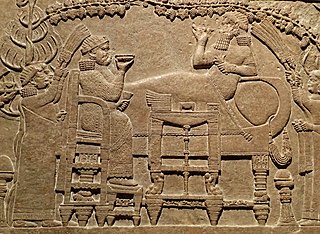
The queen of the Neo-Assyrian Empire was the consort of the Neo-Assyrian king. Though the queens derived their power and influence through their association with their husband, they were not pawns without political power. The queens oversaw their own, often considerable, finances and owned vast estates throughout the empire. To oversee their assets, the queens employed a large administrative staff headed by a set of female administrators called šakintu. Among the duties of the queens were religious responsibilities and overseeing parts of the royal palaces; their role as "rulers of the domestic realm" is reflected in their title as "Women of the Palace". The power and influence of the queens was increased further under the Sargonid dynasty (722–609 BC), when they more frequently appear in artwork and large military units directly subservient to the queen were created.


